The physics and astronomy world is all agossip: has LIGO heard its first black-hole merger? Well, not so fast.
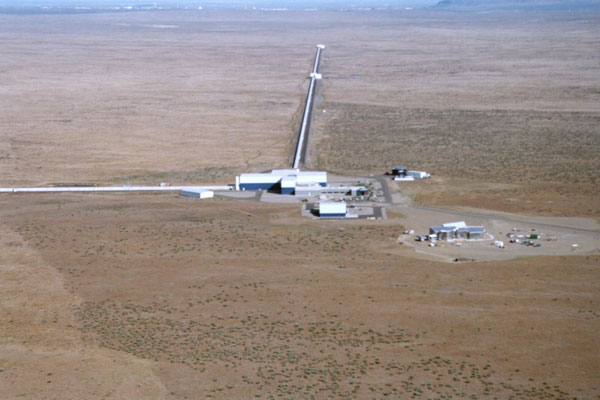
Rumors are swarming on social media that the newly upgraded LIGO, the Advanced Laser Interferometer Gravitational-Wave Observatory or aLIGO, has finally seen the gravitational-wave signature of two stellar-mass black holes spiraling together and merging. Maybe even two such events since September. Or not.
Such an observation would confirm one of the most elusive predictions of Einstein’s general theory of relativity, and it would also open a new field of cosmic observation: gravitational-wave astronomy.
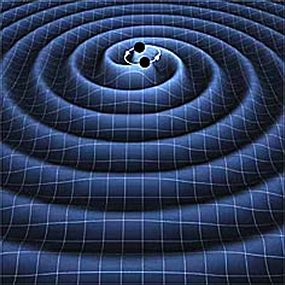
K. Thorne (Caltech) / T. Carnahan (NASA GSFC)
First, the background: According to general relativity, any accelerating mass should produce weak ripples in the fabric of spacetime itself. But it would take enormous, dense masses accelerating extremely fast to emit a significant amount of them. Neutron stars or black holes spiraling together and merging would qualify, and LIGO was built with those events particularly in mind.
As gravitational waves pass by, they stress and compress time and distance. But after traveling millions of light-years across the universe, they would be extremely weak. The typical expected signal strength would stretch and squeeze the distance from the Earth to the Sun, for instance, by the width of a hydrogen atom. Yet even that weak an effect could be detected by the laser beams bouncing back and forth along LIGO’s 4-kilometer-long vacuum pipes. It would be the first direct detection of gravitational radiation. (We already know it exists by its indirect effect of draining orbital energy away from close neutron-star binaries.) A Nobel Prize probably awaits the first direct observation. If it ever happens.
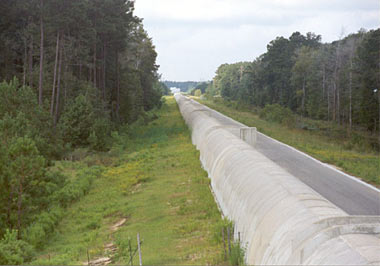
Such a feat “will open up a new window into the way we see the universe,” says astronomer Takamitsu Tanaka (Stony Brook University). Take gamma-ray bursts, for instance. These are quick, incredibly powerful explosions that are presumed to come, in some cases, from a pair of neutron stars spiraling together and merging, and in other cases from the fraction-of-a-second disruption of a dying star’s neutron-star-like core. Both kinds of cataclysm should be violent enough to send detectable gravitational waves far across the universe. “If we could see such events from gravitational-wave and conventional telescopes [both], then we can learn a lot more about the physics and what’s really going on with those events,” says Tanaka.
Still, the rumors remain just rumors. And they’re really bothering the LIGO people.
Gravitational Whispers
The gossip started spreading in physics circles just a week after the upgraded aLIGO began running in September. The rumors escaped from physics circles when cosmologist Lawrence Krauss (Arizona State University) tweeted about them on September 25th: “Rumor of a gravitational wave detection at LIGO detector. Amazing if true. Will post details if it survives.” More recently he commented that he’s 60% sure the story will pan out. Yesterday he noted the caveat that he is not one of the 900-plus members of the LIGO scientific collaboration, nor does he represent anyone there.
Steinn Sigurdsson (Pennsylvania State University), who has also speculated on the rumors via social media, says “I have absolutely no inside information on what is going on. I hear stories, I can make inferences, I can see patterns in activity. And there has been a consistent whisper for several months now that [aLIGO] saw something as soon as they turned it on.”
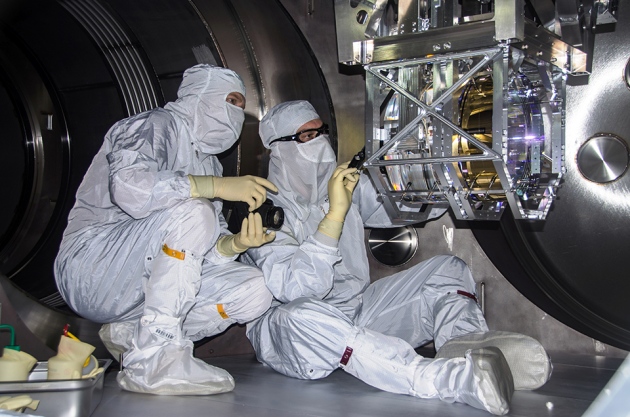
Those whispers grew to a lively babble after further tantalizing clues. First, Sigurdsson points to a flurry of papers that have appeared this week on the arXiv preprint server that were curiously specific. Astronomers, says Sigurdsson, “posted somewhat different scenarios for ways in which you could have black hole binaries form, all of which coincidentally predicted almost the exact same final configuration, and said ‘Gosh our model predicted that this very specific sort of thing will be the most likely thing that LIGO sees.’ ” And Sigurdsson isn’t the only one who has noticed. Derek Fox (Pennsylvania State University) pointed to one paper, for example, tweeting “this seems a rather specific GW [gravitational wave] scenario to pull out of thin air?”
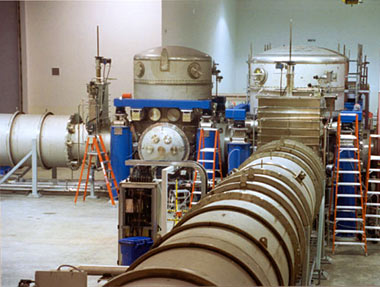
But again, Krauss, Sigurdsson, and Tanaka claim to have no privileged information. “It’s the equivalent of watching for pizza deliveries at the Pentagon,” says Sigurdsson. He’s referring to the open-source intelligence technique that Washington reporters reportedly used to spot when big events were about to emerge based on the number of late-night pizzas delivered to the White House. “You can play the same game with physicists,” he says. (Unfortunately there have been no reports of LIGO ordering an overabundance of Domino's.)
Second, it’s a small community. So when a few collaborators — who all happen to be members of LIGO — duck out of a future conference due to new overlapping commitments, it doesn’t go unnoticed. A similar pattern played out right before physicists announced the discovery of the Higgs boson. Based on dates cancelled, Sigurdsson speculates that an announcement will come from the team on February 11th.
Details of the supposed detection, however, were not publicly bandied about until Monday, when theoretical physicist Luboš Motl posted on his blog the latest version of the rumor: that aLIGO has picked up waves produced by two colliding black holes each with 10 or more solar masses. He also said he’s been told that two events have been detected.
Reason for Silence
There’s a good reason why LIGO’s people refuse to confirm or deny that something is going on. Scientists really want to get things right before they announce a major finding to the world, whether positive or negative. LIGO’s data-analysis task alone is vast and full of potential gotchas, and the most likely gravitational-wave detections would be buried deep in the noise. The experiment is looking for changes in the distance between mirrored blocks of metal 4 km apart as slight as one part in 10–22, about a thousandth the diameter of a proton. In other words, changes in measurement of 1 part in 1025. What could possibly go wrong?
Fresh on the minds of everyone in astronomy and physics is an announcement fiasco that blew up spectacularly in 2014. The astronomers of the Harvard-based BICEP2 collaboration announced to the world’s media, at a packed press conference, that they had very likely discovered primordial gravitational waves from the earliest instant of the Big Bang. The signal was unexpectedly strong. It would have been the much-sought, crowning evidence for the inflationary-universe theory of how the Big Bang happened. Not until later did their work go through full peer review. The discovery literally turned to dust — leaving a very public mess and a lot of criticism. Many dread a repeat.
The current excitement could easily be a false alarm. Even if LIGO has a promising signal, it may be a false test signal planted as a drill. It's been done before, in 2010 near the end of LIGO's last pre-upgrade run. Three members of the LIGO team are empowered to move the mirrored blocks by just the right traces in just the right way. Only they know the truth, and the test protocol is that they not reveal a planted signal until the collaboration has finished analyzing it and is ready to publish a paper and hold a press conference. “Blind tests” like this are the gold standard in all branches of science.
So we’ll just have to cool our heels. But probably not for long — a matter of weeks or months, not years.
“Essential to the Process”
A premature “discovery” getting loose, and then being denied or retracted, could diminish the public’s trust in scientists — and the scientific process — in general. “We live in a crazy time when it comes to science and the public, as the ongoing ‘debate’ about climate change shows us again and again,” wrote astronomer Adam Frank (University of Rochester) in his NPR blog on the BICEP2 fiasco in 2014. “I wish they’d have let the usual scientific process run its course before they made such a grand announcement. If they had, odds are, it would have been clear that no such announcement was warranted — at least not yet — and we’d all be better off.”
Sigurdsson, however, disagrees. When the BICEP2 team announced their results, he used it as an example in his Cosmology 101 class, encouraging students to view it as an uncertain result in mid-discovery phase. “I think most of the public appreciates the fact that you can make mistakes for the right reasons and that’s part of the process,” says Sigurdsson. “We proceed by falsification. We make conjectures, we test them, and some of the time we find that things were wrong and we throw them out. But that’s still essential to the process. We need to get that across.”
 10
10








Comments
January 13, 2016 at 9:53 pm
This is the best and most reasoned article I have seen on this subject. Thanks for taking the time.
sciencesprings
http://sciencesprings.wordpress.com
You must be logged in to post a comment.
Corey Rueckheim
January 14, 2016 at 1:37 pm
I, for one, am glad that BICEP2 made their announcement when they did, even though it was premature. First of all, I am not at all worried that it diminished the public's trust in science or in scientists. The portion of the public who care about announcements like that are also the portion who understand how the process works and see it as merely another false step on the journey to discover the truth. They also understand that "Failures are finger posts on the road to achievement." (C.S. Lewis) The portion of the public who do not care about such announcements are not likely to have paid any attention to either the announcement, or the correction! Only the conspiracy theorists are likely to be misled (but this can never be avoided anyway). Does anyone really know of someone who lost their trust in science due to the BICEP2 announcement?
More importantly, I enjoyed the BICEP2 announcement because it has added some more human interest, and even excitement, into the history of science. Who doesn't love that? Do we distrust Einstein because of his cosmological constant? No, we love him all the more! I can only hope that the rumors about LIGO lead to a story just as interesting...
I think that science could actually benefit from a little more wild speculation thrown in from time to time. Besides simply being fun, it would help to inspire people to think outside of the box a little more. What could it really hurt? The peer review process will always straighten things out before they get too far out of control.
"Far better it is to dare mighty things, to win glorious triumphs, even though checkered by failure, than to take rank with those poor spirits who neither enjoy much nor suffer much because they live in the gray twilight that knows neither victory nor defeat." (Theodore Roosevelt)
You must be logged in to post a comment.
Phil-Perry
January 17, 2016 at 1:16 pm
If all civilians were intelligent and understood the scientific process, I wouldn't worry either. Unfortunately, most non-scientists will latch on to the spectacular news, and then when it's retracted, take that as solid
evidenceproof that scientists are mendacious or at best, incompetent. Just look at the public discourse on, say, climate change or evolution. Remember, a huge percentage of the public hang on every doing of the Kardashians! Science requires intelligence and reason, something sadly lacking in most people.Science should not be conducted in secrecy. It must be out in the open. But it is a mistake to trumpet very preliminary results in very public arenas, as they may need to be retracted. That's part of science, but is very damaging in the public eye.
You must be logged in to post a comment.
Corey Rueckheim
January 27, 2016 at 3:21 am
It seems that the general public is much more sensitive to certain science results than it is to others. Specifically, science that affects our lives or livelihoods has much more impact on the general public than other science. I think good examples of this are medical studies. We get regular announcements that "this or that" causes cancer or leads to longer or shorter lifespans. The general public relies on this information in their day-to-day lives, and therefore these announcements should be very carefully vetted before being announced. But announcements like the BICEP2 announcement do not have that same kind of impact on the lives of the general public and therefore offer perfect opportunities for the public to see deeper into how the scientific process really works. Specifically, they can see how every scientific "discovery" must withstand peer review. Ultimately, this can only help the general public to develop MORE trust in science.
Global Warming and the Theory of Evolution are controversial, not because they were released prematurely, but because of the impact they have (or will have) on our day-to-day lives.
You must be logged in to post a comment.
Fred Shuman
January 14, 2016 at 5:26 pm
Trying to track down announcements I'm seeing on some of the 'fluffier' sites, of a recently announced detection of an extremely powerful & distant SN.
This was seen by the All-Sky Automated Survey for Supernovae (ASAS-SN), is designated ASASSN-15lh, identified with SN 2015-L, and was announced about a day ago or less, but I haven't found a date of observation. The ASAS-SN site talks about the first 4 months of this, so September-something, 2015?
So now I'm wondering whether this is a possible source of the LIGO rumored detection? It sounds like the right sort of event to have produced a powerful grav-wave signal, but it sounds like the timing would rule that out? What days' data were the LIGO team analyzing when they found the possible detection?
I guess we have to wait to find out whether this was even an actual detection, a false-alarm detection, or a test event.
You must be logged in to post a comment.
John
January 15, 2016 at 6:13 pm
"...changes in measurement of 1 part in 10^25..." Nicely done discussion but one item was left out: how much noise exists in the measurement environment? I find it difficult to believe something even as mundane as a minuscule earthquake or similar ground noise wouldn't cause orders of magnitude more of a signal and therefore swamp out any meaning information.
You must be logged in to post a comment.
Nigel-Rotherham
January 16, 2016 at 5:14 am
Absolutely fascinating read, thoroughly enjoyed (including comments) and this short note to concur with Corey Rueckheim that 'early exposure' of scientific news should not negatively affected public opinion of the scientific community. I believe I am qualified to make this statement being as I am a member of 'the public' with a interest in all things scientific (also the label 'Amateur Astronomer' applied by those who know me).
Fingers crossed that answers to points raised by Fred Shuman (distant SN event) and John-Bartucci (background noise levels) will be posted soon.
Best regards to all from sunny South Africa 🙂
You must be logged in to post a comment.
January 16, 2016 at 11:02 am
Even if the LIGO team ultimately makes an announcement, after surviving a rigorous peer review, that they have detected a gravitational wave, I'm still not convinced that this will be enough to be fully accepted as a true detection. Due to the possibility of contamination of just the right type of a noise that can fool the detectors, whatever positive result they announce also has to be corroborated by measurement from a different instrument made by a different team. That is why it is critical to have at least one other similar LIGO-like instrument operating in a different part of the world, where there is an extremely low probability that both can be fooled by the same type of noise. Only when multiple teams make substantially the same detection, can we then have a fairly convincing evidence of gravitational wave detection. Currently, there are other similar instruments being built or planned by other teams in other countries, so eventually we will get to a point where a detection by one team can be corroborated by others, but I don't think we are there yet. Until we are there, the LIGO announcement probably won't have as much of an impact as some would believe.
Regarding the BICEP2 incident, I also think it was good for them to make the preliminary announcement. It at least demonstrated to the public how the scientific process works, that a bold claim goes through a rigorous review process and that the scientific community is very demanding when it comes to such claims.
You must be logged in to post a comment.
January 16, 2016 at 11:34 am
I just remembered that there are actually two LIGO facilities in the US, precisely for the reasons I gave, to try to reduce the effects of noise. If the LIGO announcement is based on data obtained from both facilities and it survives rigorous review, then yes, this would be a huge announcement and could amount to a highly probable detection of a gravitational wave. Now I'm more excited and can't wait for the final result.
You must be logged in to post a comment.
Joey Egleston
January 20, 2016 at 11:39 am
To think, there are people who gossip about the Kardashians when there are exciting things like this to talk about.
You must be logged in to post a comment.
You must be logged in to post a comment.